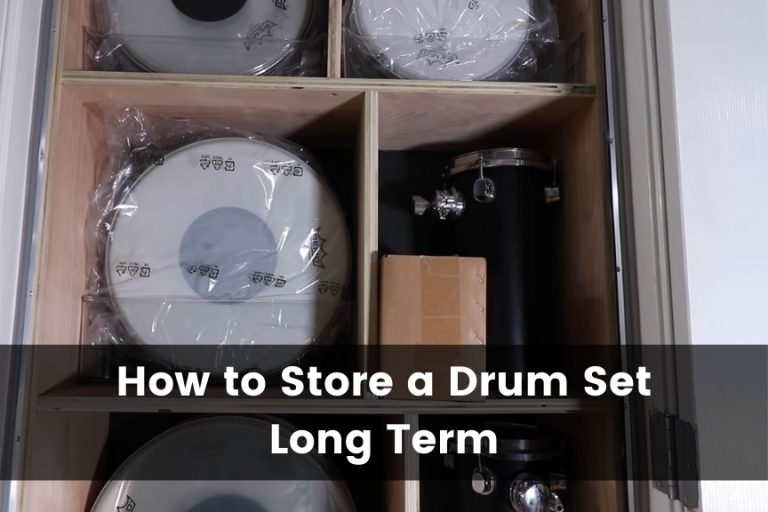How To Muffle A Bass Drum (5 Simple Ways)
The bass drum is arguably the most vital drum of any drum set. This drum is important to the sound of the kit and is musically critically as well. However, the bass drum is also the most challenging drum to control. Many drummers struggle to get their bass drum to sound as good as they want it to, which leads many to use bass drum muffing methods to change the way the drum sounds.
To muffle a bass drum, remove the resonant head and install muffling within the drum. Towels, pillows, acoustic foam, and muffling pads can all be used to muffle a bass drum. Muffling removes undesirable attributes of the drum tone and sculpts it to the drummers’ tone preferences.
Every drummer knows that muffling a bass drum is a good way to change or improve the overall tone and response of a bass drum, but not every drummer knows how to execute bass drum muffling well. Let’s explore the best ways to muffle a bass drum and learn how to execute these methods well.
How To Muffle A Bass Drum
Muffling a bass drum is an important aspect of getting the most out of the drum for your particular needs and your own unique drum sound. Every drummer is different, and every drummer prefers a particular ick drum sound, but every muffling method can be adapted to the sound of every unique drummer.
This means that there are several methods out there, and every drummer has their own method that they claim to be the best way to control a bass drum tone. However, some methods are better than others, and some do not work at all.
This leads us to the best bass drum muffling methods that have been compiled by researching the methods used by many respected drummers and by comparing the best drum tones ever recorded to determine the best tones for a bass drum across genres.
This search has led to five different muffling methods that are widely used by drummers internationally, all of which are very effective and help the drummer get the most out of their bass drum and tweak the tone of the instrument to sound exactly the way they want it.
Let’s learn the five best methods for muffling a bass drum and describe the tones that they produce to help you draw the best possible sound from your bass drum for your style.
1. How To Muffle A Bass Drum: The Two Towel Method
The two towel method for muffling a bass drum is one of the simplest yet among the most effective methods. The results from this method are a punchy, well-rounded bass drum with controllable tone and minimal resonance.
The process for implementing this method is simple. Let’s follow the steps:
Step 1: Gather a drum key and two large, very dry towels.
Step 2: Remove the resonant head from the bass drum and lay it carefully aside.
Step 3: Fold the towels in half twice and loosely roll them each into a straight cylinder.
Step 4: Place one rolled towel into the bass drum, resting on the bottom of the drum against the inside of the batter drum head. Be sure that the towel is placed evenly within the drum, not higher on one side than the other, be sure that the towel is placed in a way that keeps it in place, where it is not likely to move within the drum.
Step 5: Place the second rolled towel on the edge of the drum, halfway over the edge of the drum where the resonant head attaches. Be sure that this towel is also placed evenly and in such a way that reduces the possibility of movement within the drum.
Step 6: Replace the resonant head and tune it to your preference.
This method will help to control the tone from both drum heads and will produce a very even, well-rounded tone that is well suited for most styles. This drum will sound tight, and every beat will articulate well, making it ideal for faster playing.
2. How To Muffle A Bass Drum: The One Towel Method
The one towel method produces a slightly looser tone than the two towel method and is, therefore, better suited for drumming that requires a more open tone. This method is simple to implement and sounds especially good when used with larger bass drums.
These are the steps for using the one towel bass drum muffling method:
Step 1: Gather the largest towel you can find, preferably a beach towel or a thick bath sheet, as well as your drum key.
Step 2: Remove the resonant head from the bass drum.
Step 3: Fold the towel into a square, and then fold the opposite corners to create a triangle. Leave the triangle relatively loose.
Step 4: Roll the triangle towel inwards from the point. This brings the majority of the mass of the towel into the center and leaves less mass on the edges of the towel, creating a large center that tapers towards each end.
Step 5: Lay the bass drum on the ground with the batter side down. Be careful not to damage the drum and lay it on a soft surface such as a towel or rug.
Step 6: Place the rolled triangle into the drum, resting on the bottom of the drum and bottom edges of the batter head. Curl the towel up the inside of the drum.
Step 7: Secure the towel in place using masking tape or another type of taking that does not leave a residue once removed. This prevents the towel from unravelling within the drum while playing.
Step 8: Stand the drum upright again and replace the resonant head. Tune the head to your preferences and reinstall your pedal.
This method produces a tight yet open bass drum sound that offers a well-controlled amount of resonance and has been used by great drummers such as Dave Weckl. This is a great method for recording and live playing and produces a solid all-around bass drum tone.
3. How To Muffle A Bass Drum: The Pillow Method
Using a pillow to muffle a bass drum is a method that has been used for decades. Many drummers use this method exclusively, and many drummers are not aware of any method but the pillow method.
This method is effective for many bass drums and produces a tone that most rock drummers appreciate. It is a simple muffling technique that requires very little time or energy to implement.
The steps for using the pillow muffling method are:
Step 1: Find a pillow that you no longer use or one that you are willing to sacrifice. It is best to use a longer pillow, such as those used for sleeping with, rather than a throw pillow or something similar. Don’t forget to get your drum key as well.
Step 2: Remove the resonant head from the bass drum and set it aside.
Step 3: Carefully place the pillow within the bass drum along the bottom of the shell. Prop one end of the pillow up on the bottom edge of the batter head and try to curl the pillow up so that the opposite end will rest on the resonant head when it is replaced.
Step 4: This step is optional. Many drummers use masking take to secure the pillow to the inside of the shell. This prevents the pillow from shifting while using the drum.
Step 5: Replace the resonant head and tune the bass drum o your preferences.
This method helps to absorb some of the resonance from the drum heads on the bass drum as the pillow rests against them, which helps to control the tone of the drum and increase the decay of the sound.
The mass of the pillow within the drum, however, is the true sound dampening. The mass of the pillow absorbs much of the sound within the drum and significantly dampens the sound.
The fact that the drum heads are only slightly muffled allows for more play in the heads. This looseness, combined with the mass of the pillow, results in a strong, lively bass drum tone that is well-rounded yet crisp. Many rock drummers prefer this method of muffling.
4. How To Muffle A Bass Drum: The Muffling Pad Method
Muffling a bass drum has been a necessity since the drum was first invented. Every bass drum is different, and every bass drum sounds different, which means that there is no universal way for muffling a bass drum correctly.
However, drum manufacturers have produced a range of products that are specifically designed for muffling bass drums and altering their tone to the drummer’s preferences.
These products come in several forms, but one of the most popular are drum muffling pads. These pads are typically mounted on arms or bars that are mounted within the bass drum shell in such a way that allows the pads to press up against the drum heads from within.
This method provides very precise muffling and is usually put in place to control the sound of a particularly stubborn drum or used in conjunction with other drum muffling methods to tune the overall tone of the bass drum.
Installing this type of drum pad is effective, but it is a challenge. Let’s follow the steps to make the process as simple as possible.
Step 1: Some tools are required for this method, including a drum key, tape, a box cutter or scissors, and depending on the product that you have, a pair of pliers and a screwdriver.
Step 2: Remove the resonant head from the bass drum and place it somewhere where it will not be accidentally damaged by any of the steps.
Step 3: Determine where within the shell the pad mounts need to be placed in order to muffle the drum heads. The muffling pads should be placed so that they press against the drum head when it is in place, but not so hard that they stretch, puncture, or damage the head in any way. The same is true for both the resonant and batter heads.
Step 4: Follow the manufacturers’ instructions for installing the muffling pads, being careful not to cause any damage to your drum.
Step 5: Place any other additional muffling within the drum according to your preferences, be it more pads or other forms of muffling such as towels or pillows.
This method allows a bass drum to be muffled in a fine-tuning way. This can help to remove any specific undesirable frequencies or tones from the drum. This is ideal for drummers who are mostly happy with the tone of the drum but want to fine-tune the tone to their exact preferences.
5. How To Muffle A Bass Drum: The Muffling Foam Method
Another effective muffling product produced by drum manufacturers is muffling foam. This acoustic foam is specially designed to absorb frequencies present within bass drums and to help mitigate vibrations within the drum to reduce overall volume and alter the tone of the drum.
The process of installing this foam is similar to the first three methods that we covered, but let’s learn the steps to execute this method well.
Step 1: Gather the appropriate tools, including a drum key and scissors or a box cutter for trimming the foam if necessary and masking tape in case the foam must be secured.
Step 2: Remove the resonant head from the drum and set it aside. Keep it close, as this method will not require much time.
Step 3: Place the foam within the drum shell as you require. This may be placing the foam along the bottom of the shell, touching each drum head, or tape along the inside walls of the shell. Where to place the foam is dependent on your requirements and the type of foam that you use.
Step 4: Be sure that the foam is secured well within the drum, as it will shift and move because it is so lightweight.
Step 5: Replace the resonant head of the bass drum and test the drum.
This method can produce various results depending on the type of foam used and the placement of the foam within the drum itself.
Take the time to place the foam correctly and place it where it will have your desired impact on the tone of the bass drum. Experiment with the tone by playing the drum for a few days and moving the foam to other positions within the drum to dial in your perfect bass drum tone.
Conclusion
Muffling a bass drum is the only way to get the most out of your kit. This is true for all bass drums, regardless of price or quality level. Every bass drum can be altered or improved by implementing some simple muffling techniques.
All of these methods are accessible for every drummer, but which method is best for you is dependent on various factors. Take the time to experiment with various methods and explore the possibilities that each provides.
By playing with these muffling techniques and methods, you are sure o find the best bass drum tone for you and your style!







